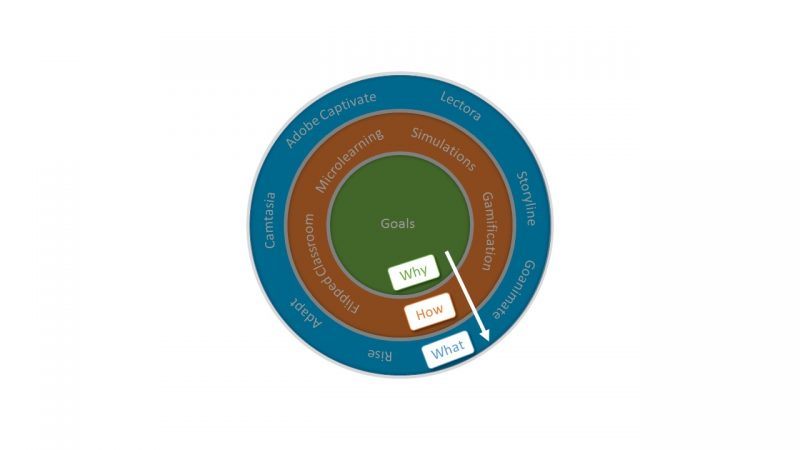Make Your eLearning Course Thrive: Apply The Golden Circle Model
"It’s not about what we do. It’s about why we do, what we do". - Simon Sinek
Recently, I’ve become a bookworm and read some great books, out of which I love the ones written by Simon Sinek called Start with Why. He is a British/American author, TED speaker, motivational speaker, and marketing consultant. He has written 4 books including this one which became a bestseller and has sold millions of copies.
The whole idea of this book is "why" we take decisions, and how those decisions help companies to reach the height of success. Simon has shared some case studies, focusing on "why" more than on "what and how", of the companies that are now owning the world.
The Golden Circle was one of the chapters of his book where he shared a case study of the Apple company, and the way Apple markets its products. They don’t sell their products with 'what they do', but 'why they do what they do'. Confused? Let me explain how:
The reason of Apple being so successful is the way Apple communicates to customers. Most companies talk about their products, features, specification, and start comparing with other products in the market. Apple sells "Why their products is worth buying". They believe in challenging status quo. They also talk about the whole user experience and comfort making products that work better and simple to use for their consumers, that’s why you feel different when it comes to Apple, or feel exceptional when you are using one of Apple’s products. For them, winning customer’s trust and loyalty are one their priorities. The rest will come later. Watch this video to understand the idea of a Golden Circle:
Why – eLearning?
If you go a few decades back, after computers were invented, eLearning was a dream for many organizations. Thinking of a virtual environment was a reverie for everyone. Even Steve Job’s belief was to bring simulated environment for higher education when he was building his another company Next:
eLearning is now a whole another domain, and has taken most of the market. There are different types of tools like authoring tools, Learning Management Systems, and Learning Record Systems help to design, manage, and monetize eLearning. We—eLearning developers, educational technologists, and Instructional Designers—are assigned to make things easier for the company and help them to increase learners' performance. So far, in order to implement the best eLearning solution in the company, we become analytical, and evaluate the best product, but sometimes we forget to include the overall impact that a product will bring to the learners' performance. Yes, you are right! I am talking about the learners. As Jonah Bozarth rightly mentioned, some of our missteps in her article Nuts and Bolts: eLearning on a Shoestring are:
- The large company that estimated first-year eLearning course usage at 30,000 people and purchased licenses accordingly. Actual first-year usage: 2,000.
- The agency that bought a product, unaware that running it would require the purchase of another product.
- The school that bought an authoring program so complex that no one could ever figure it out.
- The training unit that purchased an LMS that didn’t fit with any of the organization’s other data systems.
- The Midwestern state government system with such poor internal communication that at one point 40 different agencies had negotiated 40 different contracts—with the same eLearning vendor.
- The organization that spent half its eLearning budget on expensive game-creation software: Only one person can run it, and employees are already sick of being "gameshowed".
Solution
Since I was super amazed by Simon’s Golden Circle discovery, I keep thinking about it. All of it makes me wonder; this is exactly what we are supposed to do in eLearning, but unfortunately, not all of us do that.
We do exactly what Simon mentioned. Please, see the revised version of his diagram below.

If you see the diagram, first we identify "what", "how", and then "why".
- "What".
Select the best authoring tool that helps us to design an eLearning course. - "How".
Pick the strategy that helps our eLearning course. - "Why".
Define the purpose or goal of the eLearning course.
Currently, most of us are using this pattern to design an eLearning course. We start with "what", "how" and "why". But is it giving us great output?
According to the Harvard Business Review, US organizations spend over $160 billion dollars on employee training and education, with global figures estimated as high as $356 billion.
Nearly 75% of the senior managers and leaders in the organizations polled by CEB were dissatisfied with the performance of their L&D department.
One of the major reasons is that those companies are not achieving their goals. They put more attention on their "what", and "how", but not on the actual problem instead. One of my mentors, and an eLearning guru, Cathy Moore talks about it in one her webinar The big mistake in eLearning. She says: "Most of us are trying to solve the wrong problem. All we do is to put lipstick on the pig".

What I am suggesting here is to reverse the order of thinking. Each step will lead to the next on:
- "Why".
Define the purpose or goal of the eLearning course. - "How".
After identify that, pick the best strategy or approach that goes with it. - "What".
Once you know the purpose, choose the best strategy, and then pick the right tool that not only makes your eLearning course attractive, but which also takes less time and effort.
Let me explain this further:
The Scenario
Peter is hired as an Instructional Designer at XYZ company. Paula (Peter’s manager) gives him his task to design an eLearning course so as to improve the sales performance on the Storyline. He can also use to Camtasia if he wants to create a video. The deadline of this project is one month, and his first meeting with the SME and the Stakeholders in a few days. Since this is Peter’s first task, he has to impress his manager. He should prepare himself for the meeting.
Let’s apply what's actually happening in today’s world:
- "What".
Peter knows about the Storyline very well. It will be easier for him to get on the tool, and start working on the project. - "How".
Peter is confused between the strategies, but based on prior experiences,he thinks it would nice to apply gamification to his eLearning course. It’s easier and needs less effort for him. - "Why".
He sets a meeting with the stakeholders and the Subject Matter Expert, and explains the reason why he’s going to create an eLearning course. Stakeholders and SMEs are confused, and stop him. They tell him that the eLearning he assigns is for call center agents, who have very limited time for training. He should design something short, concise, which should be not more than 10 minutes.
Let’s rewind, and apply the Golden Circle to eLearning.
"Why"
When he is asked to prepare himself for the meeting, he must go through all the content given beforehand, and prepare a list of questions that he is supposed to ask the Stakeholders and SMEs so as to know all about the learners. For example:
- Why do you want to design this course?
- What is the goal of this course?
- Who is the learner?
- How long should those courses be?
"What"
After having a very informative meeting with the Stakeholders and SMEs, Peter goes through all the notes and realizes that it would be great if he designs a microlearning that gives core information and helps agents to take advantage of the limited training time.
"How"
The best way to do it is to create short videos on Camtasia, and create few engaging slides, and wrap the course on Articulate storyline. Then, he can upload them on LMS if hosted or on SCORM cloud for tracking and reporting purposes.
Some of us already do this, understanding why eLearning is essential for learners. Why should they pick your course? Why will this course have an impact on the learner’s life? Does this really impact the learners' performance? Learners could be either employees or students. If we don’t use the Golden Circle, then it will not only affect our job, but it will also hurt the overall organization.








